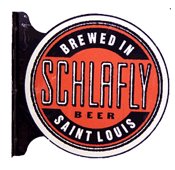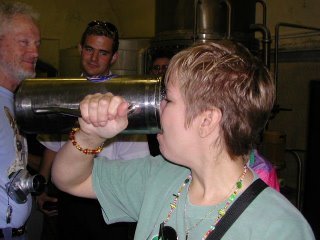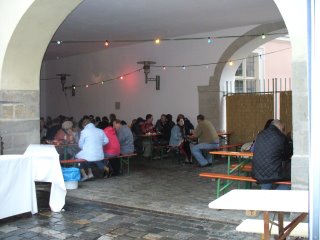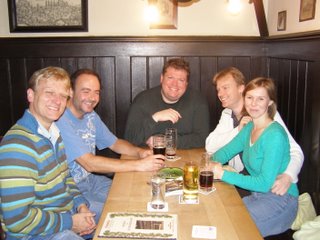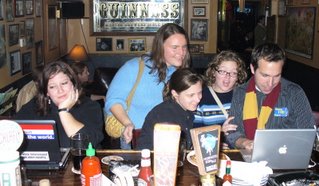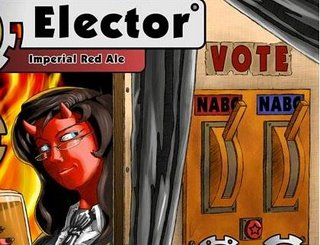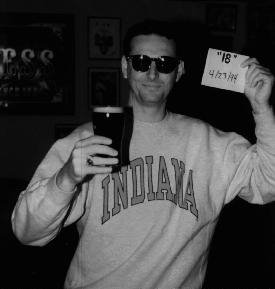 As of today, the list has reached 603. Granted, there are a few ciders within, and I've not yet perfected the filing system (roughly speaking, by brewery), but take my word for it: Tough getting even this far.
As of today, the list has reached 603. Granted, there are a few ciders within, and I've not yet perfected the filing system (roughly speaking, by brewery), but take my word for it: Tough getting even this far.
UPDATED: BARD is underway and my eyes are killing me.
BARD - BEER ARCHIVE RESEARCH DIVISION: This is a long-term archival and archaeological project to match recollections with invoices and other evidence, and to assemble a master list of draft beers served at the Public House and Pizzeria since 1990. Currently BARD is under construction.
Abbaye des Rocs Grand Cru
Abita Amber
Abita Purple Haze
Abita Turbo Dog
Achouffe Chouffe Biere de Soleil
Achouffe Chouffe Biere de Mars
Achouffe Chouffe Bok
Achouffe Chouffe La Gnomette
Achouffe Houblon Chouffe
Achouffe McChouffe
Achouffe La Chouffe
Achouffe N’Ice Chouffe
Adnams Sufflok Special Bitter
Adnams Broadside Original Ale
Adnam’s Tally Ho Barley Wine
Allagash Dubbel
Allagash Tripel
Anchor Liberty Ale
Anchor Old Foghorn Barley Wine
Anchor "Our Special Ale"
Anchor Porter
Anchor Steam
Anderson Valley Boont Amber Ale
Anderson Valley Barney Flats Oatmeal Stout
Anderson Valley Belk’s ESB
Anderson Valley Brother David’s Belgian-style Dubbel
Anderson Valley Hop Ottin' IPA
Anderson Valley Horn of the Beer Barley Wine
Anderson Valley Poleeko Gold Pale Ale
Arcadia London Porter
Arcadia Scottish Ale
Artvelde Grand Cru
Augustijn
Avery 14’er ESB
Avery Beast
Avery Czar
Avery Eleven
Avery Hog Heaven
Avery IPA
Avery Karma Ale
Avery Maharajah Imperial IPA
Avery New World Porter
Avery Old Jubilation
Avery Reverend
Avery Salvation
Ayinger Jahrhundert
Ayinger Oktober Fest Marzen
Baderbrau Bock
Baderbrau Pilsener
Barley Island Black Majic Stout
Barley Island Bourbon Barrel-Aged Oatmeal Stout
Bass Ale
BBC Alt
BBC American Pale Ale (APA)
BBC Bearded Pat's Barley Wine
BBC Black Raspberry Mead
BBC Black Silk Smoked Porter
BBC Black Sunshine
BBC Dark Star Porter
BBC Ebeneezer
BBC ESB
BBC Gold
BBC Hell for Certain
BBC Imperial Stout (cask-conditioned)
BBC IPA
BBC Kentucky Common
BBC Luna de Miel (mead)
BBC Mephistopheles Metamorphosis
BBC Monk’s Brown
BBC Nut Brown Ale
BBC Oat Malt Stout
BBC Oatmeal Stout
BBC Old Burley Barley Wine
BBC Old St. Matthews Ale
BBC Organic Amber
BBC Professor Gesser’s Mind Numbing Ale
BBC Rauchbier
BBC Ultra (Homewrecker)
BBC Weizen Bock
BBC White Wedding
BBC Wit
BBC Brewing Company Monk’s Pale Ale
BBC Brewing Jefferson’s Reserve Bourbon Barrel Stout
Belhaven Scottish Ale
Belhaven Twisted Thistle IPA
Belhaven Wee Heavy
Bell’s Amber
Bell’s Batch 5000
Bell’s Batch 6000
Bell’s Batch 7000
Bell’s Best Brown
Bell’s Cherry Ale
Bell’s Cherry Stout
Bell’s Consecrator Doppelbock
Bell’s Double Cream Stout
Bell’s Expedition Stout
Bell’s Harry McGill’s Spiced Stout
Bell’s Hell Hath No Fury
Bell’s Hop Slam Imperial IPA
Bell’s Java Stout
Bell’s Kalamazoo Stout
Bell’s Oatmeal Stout
Bell’s Oberon Ale
Bell’s Octoberfest Beer
Bell’s Pale Ale
Bell's Porter
Bell’s Rye Stout
Bell’s Sparkling Ale
Bell’s Susie’s Sweet Stout
Bell’s Third Coast Beer
Bell’s Third Coast Old Ale
Bell’s Trumpeter Stout
Bell's Two Hearted Ale
Bell’s Winter White Ale
Black Biddy Irish Stout
Black Sheep Riggwelter
Bloomington Brewing Co. Batch 500 India Pale Ale
Bloomington Brewing Company Java Porter
Bloomington Brewing Company Ruby Bloom Amber
Bloomington Brewing Company Quarrymen Pale Ale
Boddington’s
Breckinridge "Small Batch" 471 IPA
Brooklyn Best Bitter
Brooklyn Brewery Monster Ale
Browning’s Doppelbock
Browning’s (single varietal) ESB
Browning’s Hercules Ale
Browning’s IPA
Burgerbrau Aktionator
Burgerbrau Nikolaus Bier (Altfrankisches Dunkel)
Burgerbrau Oktoberfest-Bier
Burgerbrau Wolnzacher Roggenbier
Burton Bridge Bitter
Burton Bridge Old Expensive
Burton Bridge Thomas Sykes Old Ale (cask-conditioned)
Cantillon Gueuze
Carlsberg
Celebrator Doppelbock
Celis Dubbel
Celis Grand Cru
Celis Pale Ale
Celis Raspberry Wheat
Celis White
Christoffel Winter Bock
Circle V Batch 100
Circle V Brickyard Red
Circle V Muddy Waters Brown
Circle V Oktoberfest
Circle V Pacer Pale Ale
Circle V Venus Pilsner
Clipper City (Heavy Seas) Below Decks
Corsendonk Christmas Ale
Corsendonk Monk’s Brown
Corsendonk Monk’s Pale
Cumberland Brews IPA
Cumberland Brews Red
DAB
Dark Horse Crooked Tree IPA
Dark Horse Double Crooked Tree IPA
Dark Horse Sapient Trip
Dark Horse Tres Blueberry Stout
De Dolle Arabier
De Dolle Boskeun
De Dolle Dulle Teve (Mad Bitch)
De Dolle Oerbier
De Dolle Special Extra Export Stout
De Dolle Stille Nacht
De Ranke Guldenberg
De Ranke Pere Noel
De Ranke XX Bitter
Delirium Nocturnum
Delirium Noel
Delirium Tremens
Dinkel Acker Dark
Dogfish Heads 60 Minute IPA
Dogfish Head 90 Minute IPA
Dogfish Head 120 Minute IPA
Dogfish Head ApriHop
Dogfish Head Punkin Ale
Dortmunder Union Dark
Dos Equis
Double Diamond
Eggenberg Ur-Bock
EKU 28
Einbecker Heller Bock
Einbecker Mai-Urbock
Einbecker Schwarzbier
Einbecker Urbock Dunkel
Etienne Dupont Cidre Reserve
Ettaler Dunkel
Fantome Ete
Fantome Pissenlit
Fantome Saison
Faust
Flying Dog Doggie Style Pale
Flying Dog Dogtoberfest
Flying Dog Gonzo Imperial Porter
Flying Dog Horn Dog Barley Wine
Flying Dog In Heat Wheat
Flying Dog K-9 Cruiser
Flying Dog Old Scratch
Flying Dog Tire Biter
Founders Black Rye
Founders Centennial IPA
Founders Blushing Monk Belgian Razz
Founders Devil Dancer Triple IPA
Founders Dirty Bastard
Founders Red’s Rye
Franziskaner Hefe-Weizen
Franziskaner Hefe-Weizen Dunkel
Freeminer Deep Shaft Stout
Freeminer Trafalgar India Pale Ale
Fuller's E.S.B
Fuller’s India Pale Ale
Fuller’s London Porter
Fuller’s London Pride
Gaffel Kolsch
Gale’s Christmas Ale
Gale’s Conquest Masterbrew
Gale’s Festival Mild
Gale's HSB
Gales Millennium Ale
Gale’s Prize Old Ale
Geants Goliath Tripel
Goose Island Christmas Ale
Goose Island Hex Nut Brown
Goose Island Honker's Ale
Goose Island IPA
Goose Island Kilgubbin Red
Goose Island Oktoberfest
Goose Island Summertime Kolsch
Gosser
Gouden Carolus Classic
Gouden Carolus Noel
Gouden Carolus Tripel
Great Divide Fresh Hop Ale
Great Divide Hercules Double IPA
Great Divide Hibernation Ale
Great Divide Old Ruffian barley Wine
Great Divide Yeti Imperial Stout (Oaked)
Great Divide Yeti Imperial Stout
Great Lakes Anniversary Ale
Great Lakes Blackout Stout
Great Lakes Burning River Pale Ale
Great Lakes Christmas Ale
Great Lakes Conway’s Irish Red Ale
Great Lakes Dortmunder Gold
Grotten Brown
Guinness Stout
Gulden Draak
Gwatkin Yarlington Mill
Gwatkin Scrumpy
Gwatkin Blakeney Red Perry
Hacker-Pschorr Pschorr-Brau Hefe Weiss
Hacker-Pschorr Pschorr-Brau Maibock
Hacker-Pschorr Pschorr-Brau Original Oktoberfest
Hair of the Dog Adam
Hair of the Dog Fred
Hair of the Dog Golden
Hair of the Dog Rose
Hambleton Nightmare Yorkshire Porter
Harpoon IPA
Harvey’s Sussex Best
Harviestoun Bitter & Twisted
Harviestoun Old Engine Oil
Harviestoun Old Engine Oil Reserve (matured in Dalmore casks)
HB (Hofbrau)
Holsten Festbock
Indianapolis Brewing Co. Dusseldorfer Dark
J.W. Lees Moonraker Strong Ale
J.W. Lees Vintage Harvest Ale (Calvados aged)
J. W. Lees Vintage Harvest Ale (Willoughbys Crusted Port aged)
J.W. Lees Vintage Harvest Ale (Sherry aged)
J.W. Lees Vintage Harvest Ale (Lagavulin aged)
J.W. Lees Vintage Harvest Ale
Jenlain Farmhouse Ale
Jever Pilsener
Jopen Koyt
Kasteel Biere de Chateau
Kasteel K-8
Kasteel Red
Kasteel Tripel
Kostritzer Schwarzbier
Kiuchi Hitachino Nest Japanese Classic Ale
Kiuchi Hitachino Nest New Year’s Celebration Eisbock
Kiuchi Hitachino Nest Real Ginger Ale
Kiuchi Hitachino Nest Red Rice Ale
Kiuchi Hitachino Nest Sweet Lactose Stout
Kulmbacher Eisbock G’frorns
Kulmbacher Monchshof Schwarzbier
Kwak
La Rulles Cuvee Meilleurs Veoux “Best Holiday Wishes”
La Rulles Summer
La Rulles Tripel
La Trappe Dubbel
La Trappe Enkel
La Trappe Quadrupel
La Trappe Tripel
Left Hand Imperial Stout
Left Hand Milk Stout
Leipziger Gose
Liefman’s Goudenband
Lindemans Cassis
Lindemans Framboise
Lindemans Kriek
Lindemans Peche
Lucifer
Maclay Eighty Shilling
Maclay Oat Malt
Maclay Scotch
Maclay Wallace IPA
Mahr’s Christmas Bock
Mahr’s Der Weisse Bock
Mahr’s Hell
Mahr’s Ungespundet Lager
Manchester Star
Mannekin Pis
Matt’s, Kevin’s and Roger’s Mesquite Smoked Centennial Hopped Pale
Mauldons Black Adder
McAuslan’s Oatmeal Stout
McEwan’s Export Ale
Mestreechs Aajt Flemish Red Ale
Mishawaka Dominator Doppelbock
Mishawaka Founders Stout
Monk's Cafe Flemish Sour Ale
NABC Artemsia
NABC Beak’s Best
NABC Black Hand
NABC Blonde Abbey
NABC Bob’s Old 15B
NABC Bonfire of the Valkyries
NABC Bourbondaddy/Haggisdaddy
NABC Bush Hog
NABC Community Dark
NABC ConeSmoker
NABC Croupier IPA
NABC Elector
NABC Elector Select
NABC Haggisdaddy
NABC Homecoming Common
NABC Hoosier Daddy
NABC Hop Scotch
NABC Hoptimus
NABC Jenever
NABC Homecoming Common
NABC Kaiser 2nd Reising
NABC Merckx
NABC Mt. Lee
NABC Naughty Claus
NABC NobleSmoker
NABC Oaktimus
NABC Old Lightning Rod (Poor Richard’s Ale)
NABC Phoenix Kentucky Komon
NABC St. Alfonzo
NABC St. Radegund
NABC Saison Scalawag
NABC Silent Oath
NABC Solidarity
NABC Strathpeffer Heather
NABC Stumble Bus
NABC Thunderfoot
NABC Tunnel Vision
NABC Turbo Hog
New Holland Black Tulip Trippel Ale
New Holland Blue Goat Doppelbock
New Holland Dragon’s Milk
New Holland Phi
New Holland Pilgrim’s Dole Wheatwine Style Ale
New Holland Red Tulip
New Holland The Poet
Newcastle Brown
North Coast Old 38
North Coast Old Rasputin Russian Imperial Stout
North Coast Old Stock Ale
North Coast PranQster
North Coast Red Seal Ale
North Coast Scrimshaw
Oaken Barrel Epiphany
Oaken Barrel Gnawbone Pale Ale
Oaken Barrel Indiana Amber
Oaken Barrel Saison
Oaken Barrel Snake Pit Porter
Oaken Barrel Super Fly IPA
Old Slug Porter
Old Speckled Hen (nitro)
Oldenberg Blonde
Oldenberg Holy Grail Nut Brown
Oldenberg Oatmeal Stout
Oldenberg Outrageous Bock
Oldenberg Premium Verum
Oldenberg Weisse
Paulaner Hefe Weizen
Paulaner Oktoberfest
Paulaner Salvator Doppelbock
Pilsner Urquell
Pipkin Brown Ale
Pipkin Bourbon Barrel Porter (Woodford Reserve Barrel aged)
Pipkin Bourbon Barrel Stout
Pipkin India Pale Ale
Pipkin Pale Ale
Pipkin Porter
Piraat
Poperings Hommel Ale
Pyramid Snow Cap
RCH Pitchfork
Redhook ESB
Regenboog 't Smisje Blond
Regenboog ‘t Smisje BBBourgondier
Regenboog 't Smisje Dubbel
Regenboog 't Smisje Kerst
Regenboog t’Smisje Speciale (i.e., Halloween)
Regenboog Guido
Regenboog Wostyntje
Reissdorf Kolsch
Rich O’s Public House Tunnel Vision (Tucker/Oldenberg brewed)
Ridgeway Bad Elf Winter’s Ale
Ridgeway Espresso Grande Stout
Ridgeway Lump of Coal
Ridgeway Santa’s Butt
Ridgeway Seriously Bad Elf
Ridgeway Very Bad Elf
Ringneck Brewing FOTB Barley Wine
Ringneck Brewing Old 21 Imperial IPA
Rockies Brewing Hazed and Infused
Rockies Brewing Company Mojo IPA
Rocky River (Cleveland, OH) Kohlminator Smoked Bock
Rocky River (Cleveland, OH) Space Monkey
Rocky River (Cleveland, OH) Zeus Juice
Rogue American Amber
Rogue Artisan Lager
Rogue Brew 5000 OBF 2001 Belgian Dubbel
Rogue Brutal Bitter
Rogue Buckwheat Ale
Rogue Chocolate Stout
Rogue Dead Guy Ale
Rogue Dry-Hopped Red
Rogue Festive Ale
Rogue Half-e-Weizen (formerly Mo Ale)
Rogue Hazelnut Brown Nectar
Rogue Honey Cream Ale
Rogue Imperial Pilsner
Rogue Incinerator (smoked doppelbock)
Rogue JLS Alt Bier
Rogue JLS Brewer
Rogue JLS Frosty Frog
Rogue JLS Glen
Rogue JLS Hop Heaven
Rogue JLS Imperial Porter
Rogue JLS Integrity IPA
Rogue JLS Love & Hoppiness
Rogue JLS Monk Madness
Rogue JLS SchwartzBier
Rogue JLS Skull Splitter
Rogue Jubilee Ale (Horse Brass Pub’s 25th anniversary Ale)
Rogue McRogue Scotch Ale
Rogue Mexicali Ale (later Rogue Chipotle)
Rogue Mocha Porter
Rogue Mogul Madness
Rogue Morimoto Black Obi Soba Ale
Rogue Morimoto Imperial Pilsner
Rogue Morimoto Soba Ale
Rogue Oregon Brewers Festival 2002 “Charlie” (IPA)
Rogue Oregon Golden Ale
Rogue Roguetoberfest
Rogue Rose Festival Ale
Rogue Santa’s Private Reserve
Rogue Shakespeare Stout
Rogue Smoke
Rogue Uber-Pils
Rogue XS I2PA
Rogue XS Imperial Stout
Rogue XS Old Crustacean Barley Wine Vintage 1996
Rogue Yellow Snow (later Juniper Ale)
Rogue Younger's Special Bitter
Samichlaus
Samuel Adams Octoberfest
Samuel Adams Boston Lager
Samuel Adams Cherry Wheat
Samuel Adams Dark Wheat
Samuel Adams Double Bock
Samuel Adams Honey Porter
Samuel Adams Summer
Samuel Adams Stock Ale
Samuel Adams Winter Lager
Sarah Hughes Dark Ruby
Scaldis Noel
Schlafly American Pale Ale (Expedition Reserve)
Schlafly Christmas Ale
Schlafly Coffee Stout
Schlafly Hefeweizen
Schlafly Kolsch
Schlafly Oktoberfest
Schlenkerla Fastenbier
Schlenkerla Rauchbier Marzen
Schlenkerla Rauchbier Urbock
Schlenkerla Weizen
Schneider Aventinus Eisbock
Schneider Aventinus Weizen Doppelbock
Schneider Weisse
Schneider Wiesen Edel-Weisse
Scotch de Silly
Shipyard Old Thumper Ale
Shmaltz Bittersweet Lenny's R.I.P.A.
Shmaltz He’Brew Jewbelation 5766
Sierra Nevada Bigfoot
Sierra Nevada Brown Ale
Sierra Nevada Celebration Ale
Sierra Nevada Harvest Ale
Sierra Nevada IPA
Sierra Nevada Maibock/Pale Bock
Sierra Nevada Pale Ale
Sierra Nevada Summerfest
Silo Hercules (brewed by BBC)
Smithwick’s Ale
Spaten Oktoberfest
Spaten Optimator Doppelbock
Spaten Pilsner
Spaten Premium Bock (Maibock)
Spaten Premium Lager
Spezial Rauchbier
Sprecher Special Amber
Sprecher Oktoberfest
St. Feuillien Cuvee de Noel
St. Georgenbrau Keller Bier
Starpramen
(Stone) Arrogant Bastard Ale
(Stone) Arrogant (Oaked) Bastard Ale
Stone Double Bastard
Stone Imperial Stout
Stone IPA
Stone Old Guardian Barley Wine
Stone Ruination IPA
Stone Smoked Porter
Strubbe Doedel
Summit Extra Pale
Summit Winter Ale
Super Bowl 3 Smoked Hop Ale (Cumberland Brews)
Swale’s Whitstable Oyster Stout
Terre Haute Brewing Gold Label Bock
(Thomas Family Winery) Gale’s Hard Cider
Three Floyds Alpha King
Three Floyds Alpha Klaus
Three Floyds Behemoth Barley Wine
Three Floyds Black Sun Stout
Three Floyds Brian Boru
Three Floyds Calumet Kolsch
Three Floyds Dreadnaught IPA
Three Floyds Extra Pale Ale
Three Floyds Gumball Head
Three Floyds Pride and Joy
Three Floyds Rabbid Rabbit
Three Floyds Robert the Bruce
Triple Karmeliet
Troubadour
Tucker Blackberry Wheat
Tucker Brown
Tucher Hefe Weizen
Tucker Pale Ale
Tucker Smoked Porter
Tucker Wheat
Two Brothers Bare Tree Barley Wine Style Weiss Beer
Two Brothers Bitter End Pale Ale
Two Brothers Cane & Ebel
Two Brothers Dog Days Dortmunder
Two Brothers Domaine Dupage French Country Ale
Two Brothers Heavy Handed IPA
Two Brothers Hop Juice Double IPA
Two Brothers NorthWind Imperial Stout
Uerige Classic Altbier
Uerige Doppel Sticke
Uerige “Secret” Sticke Altbier
Unibroue Maudite
Upland Amber Ale
Upland Bad Elmer’s Porter
Upland Bavarian Castle Bock
Upland Castle Rock Irish Red
Upland Chocolate Stout
Upland Dragonfly IPA
Upland Maibock
Upland Oktoberfest
Upland Pale Ale
Upland Session Ale
Upland Valley Weizen
Upland Winter Warmer
Upland Wheat
Urthel Hop-It Belgian IPA
Urthel Samaranth Quadrium
Vapeur Cochonette
Victory Golden Monkey
Victory Imperial Stout
Warsteiner Premium
Warsteiner Premium Dunkel
Watney’s Red Barrel
Weihenstephaner Dunkel Weizen
Weihenstephan Hefeweissbier
Weihenstephaner Korbinian Doppelbock
Whitbread
Wye Valley Butty Bach
Wye Valley Dorothy Goodbody’s Our Glass
Young’s Double Chocolate Stout (nitro)
Young's Ram Rod
Young’s Oatmeal Stout
Young’s Winter Warmer
Zwiec Lager
 Thursday is St. Andrews Day.
Thursday is St. Andrews Day.
